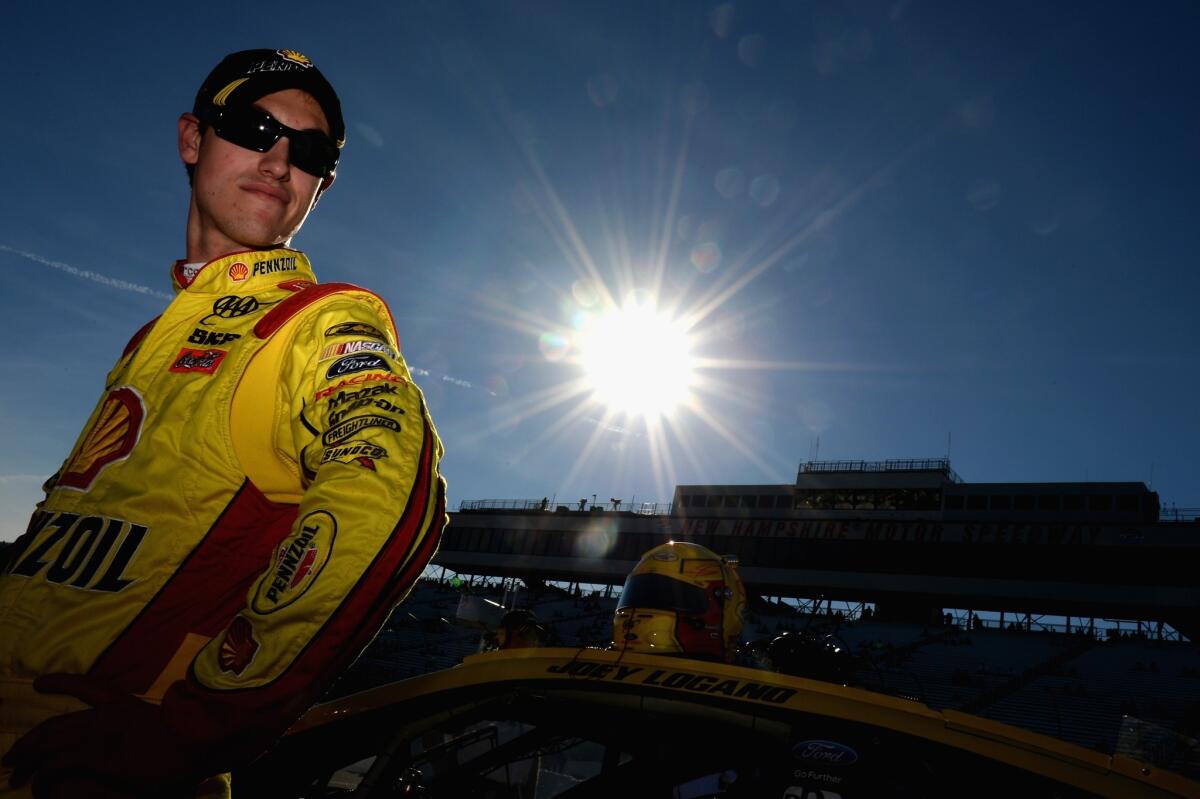NASCAR’s Hollywood road map aims to boost sport’s popularity

Far from the roar of a race track, one can hear a pin drop in the spacious 30th floor Century City office of NASCAR Vice President Zane Stoddard, which has a spectacular high-rise view of nearby Hollywood.
On this day Stoddard has a conference with Hollywood producer Neal Edelstein, whose films have included dramas (“Mulholland Drive”), mysteries (“The Ring”) and horror movies (“Haunting Melissa”).
Edelstein wants to make a movie centered on a NASCAR driver, an idea pitched to him by Stoddard. And they’re meeting to discuss how Universal Pictures, which agreed to finance the movie’s early development, views the initial script.
Why a NASCAR-related film? There’s been an “explosion of action sports in this country,” Edelstein says during a break. “Well, the original action sport is NASCAR. It has great texture for movies.”
The film is one of several projects being pursued by Stoddard and his nine-person NASCAR Entertainment Marketing staff to infiltrate pop culture with everything NASCAR in order to boost stock-car racing’s sagging popularity. They also arrange driver cameos on television shows, develop new NASCAR-themed programs for TV and online outlets and bring celebrities to NASCAR races.
“We’re creating entry points to our sport for new fans who may not necessarily … go looking for a race,” said Stoddard, 44, who joined NASCAR in 2010 after several years in a similar post with the NBA.
Stoddard’s efforts are needed because NASCAR’s popularity, though still among the highest in U.S. sports, has dropped from its peak in 2004-08. Tracks aren’t filling every seat for the sport’s premier 36-race Sprint Cup Series as they once did. And while 4 million to 8 million people still watch Cup races each weekend, NASCAR TV ratings are down 8% to 18% from five years ago, depending on the race and the TV carrier (NASCAR races are divided among Fox, ESPN and TNT).
That has required NASCAR Entertainment to, well, shift gears. The local office, opened in 2000, initially focused mostly on movies and simply exploited the huge attention then paid to the sport. One big score was the film “Talladega Nights” in 2006, which supposedly got the green light with no more of a premise than “Will Ferrell as a NASCAR driver.”
But NASCAR knows that to now reignite its growth, it needs to widen its fan base and do so via the different ways entertainment is now consumed.
Currently, 83% of the sport’s fans are over age 29 and 78% are white, according to Scarborough Research in New York. So Stoddard’s office is pushing to get NASCAR in front of younger and multicultural audiences.
NASCAR Entertainment spearheaded a reality show about a teen-age NASCAR driver, called “Flat Out,” that debuted last week on AOL’s On Network website. A NASCAR-themed telenovela, “Arranque de Pasion,” aired on Spanish-language Univision and is available on Univision’s website as part of NASCAR’s bid to gain a larger Latino following.
At the Nickelodeon Kids’ Choice Awards in Los Angeles this year, the award for favorite female athlete went to NASCAR driver Danica Patrick, and she didn’t win by chance. NASCAR Entertainment pitched her to Nickelodeon as a nominee. Earlier this year NASCAR driver Joey Logano appeared on Cartoon Network’s Hall of Games Awards show and driver Trevor Bayne was a presenter on the Radio Disney Music Awards.
At the same time, NASCAR is adapting to new ways programs are viewed on computers, smartphones and other digital devices, programs that often are shorter than the conventional one hour- or 30-minute TV shows.
Case in point: “Flat Out,” a reality show that follows driver Dylan Kwasniewski, 18, who has excelled in NASCAR’s minor leagues.
NASCAR teamed with Vuguru, a studio founded by former Walt Disney Co. chief Michael Eisner, to develop “Flat Out” as an online program and sold it to AOL Inc. Tentative plans call for 10 to 15 episodes of about five minutes each.
“The younger audience is very used to watching short-form video whenever they want, wherever they are,” Vuguru Chief Executive Larry Tanz said.
But NASCAR isn’t selling just racing with “Flat Out.” It’s mainly selling Kwasniewski’s story, which tracks how he’s handling his life and fledgling career after his father, a Las Vegas hotel executive, committed suicide in 2010.
Gabriel Lewis, head of AOL Studios, said that while NASCAR “as a brand carries weight,” ultimately “Dylan’s story is really what sold us.”
Stoddard said that’s often true of all of NASCAR’s pitches. “You’ve got to have great stories” to get programs made in Hollywood, he said. “It’s not enough to just show up and say, ‘We’re NASCAR, we’ve got tens of millions of fans.’”
The NASCAR-themed “Arranque de Pasion” stars acclaimed Mexican actress Kate del Castillo. To help promote the show, NASCAR arranged for Del Castillo to be the honorary starter at NASCAR’s Sprint Cup Series race at Auto Club Speedway in Fontana last March.
Such efforts are critical to drawing more Latinos to NASCAR, said Auto Club Speedway President Gillian Zucker, who has aggressively pursued her own diversity initiatives.
While Latinos make up 9% of NASCAR’s overall fan base, they’re 38% of those attending Zucker’s races. Programs such as the telenovela are “all about piquing [Latino fans’] interest” in NASCAR, she said.
The bottom line, of course, is whether the entertainment push helps lift NASCAR’s national attendance and TV ratings, and Stoddard said it’s too early to tell.
NASCAR Entertainment’s strategy is part of a five-year plan NASCAR announced in 2011 to grow the sport. “When we get to the end of that five years,” Stoddard said, “we will have a very clear measurement of where we are.”
Twitter: PeltzLATimes
More to Read
Go beyond the scoreboard
Get the latest on L.A.'s teams in the daily Sports Report newsletter.
You may occasionally receive promotional content from the Los Angeles Times.










